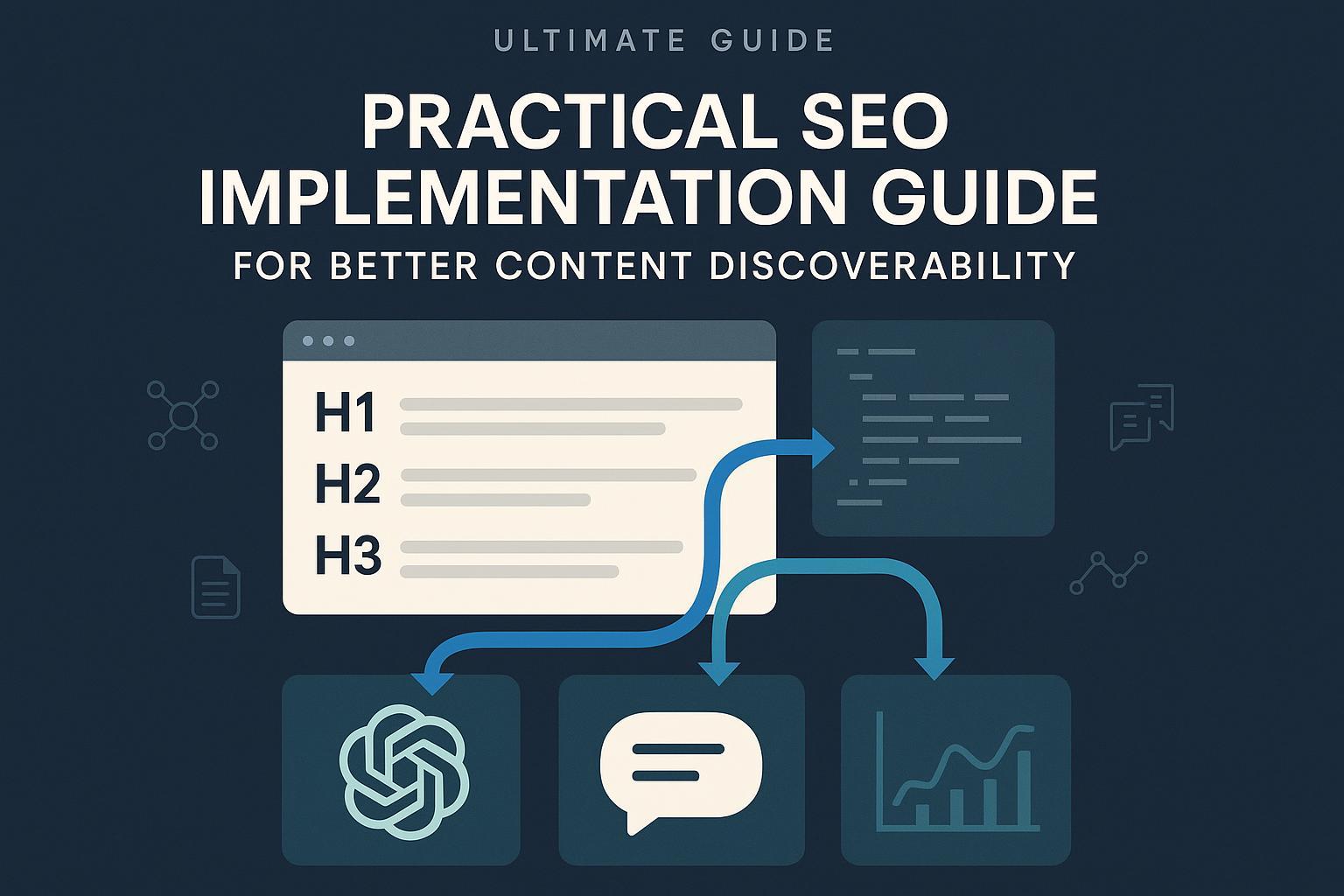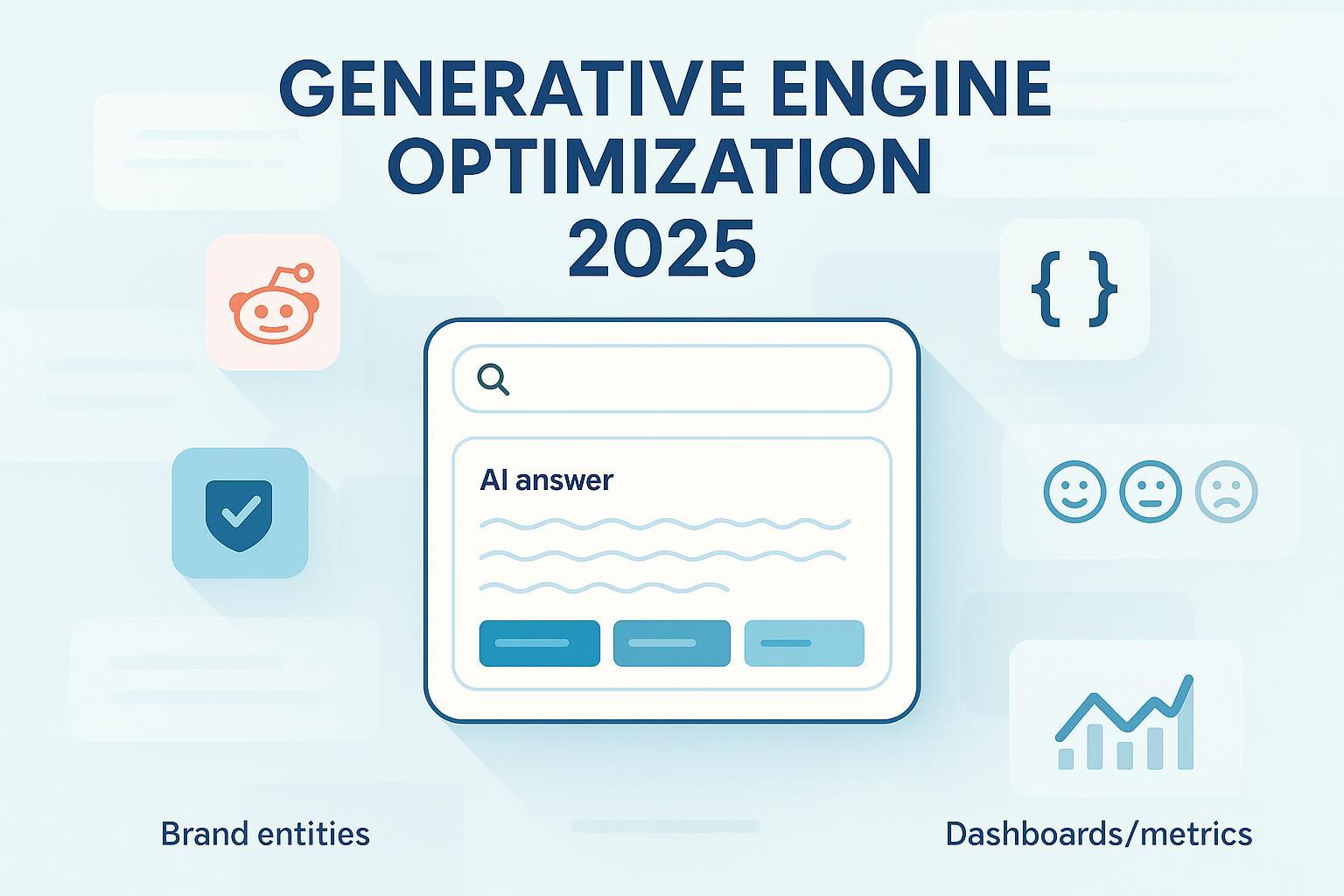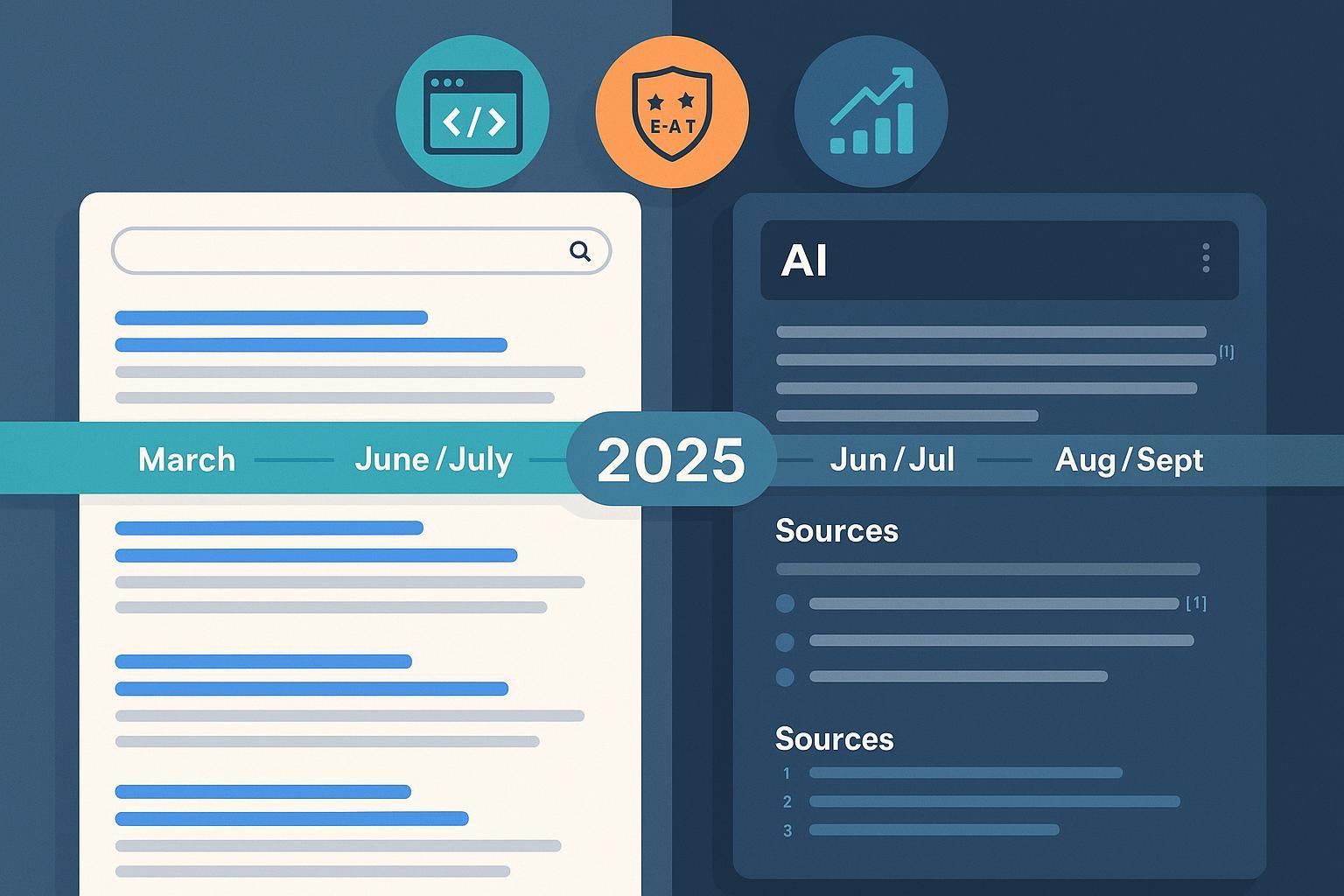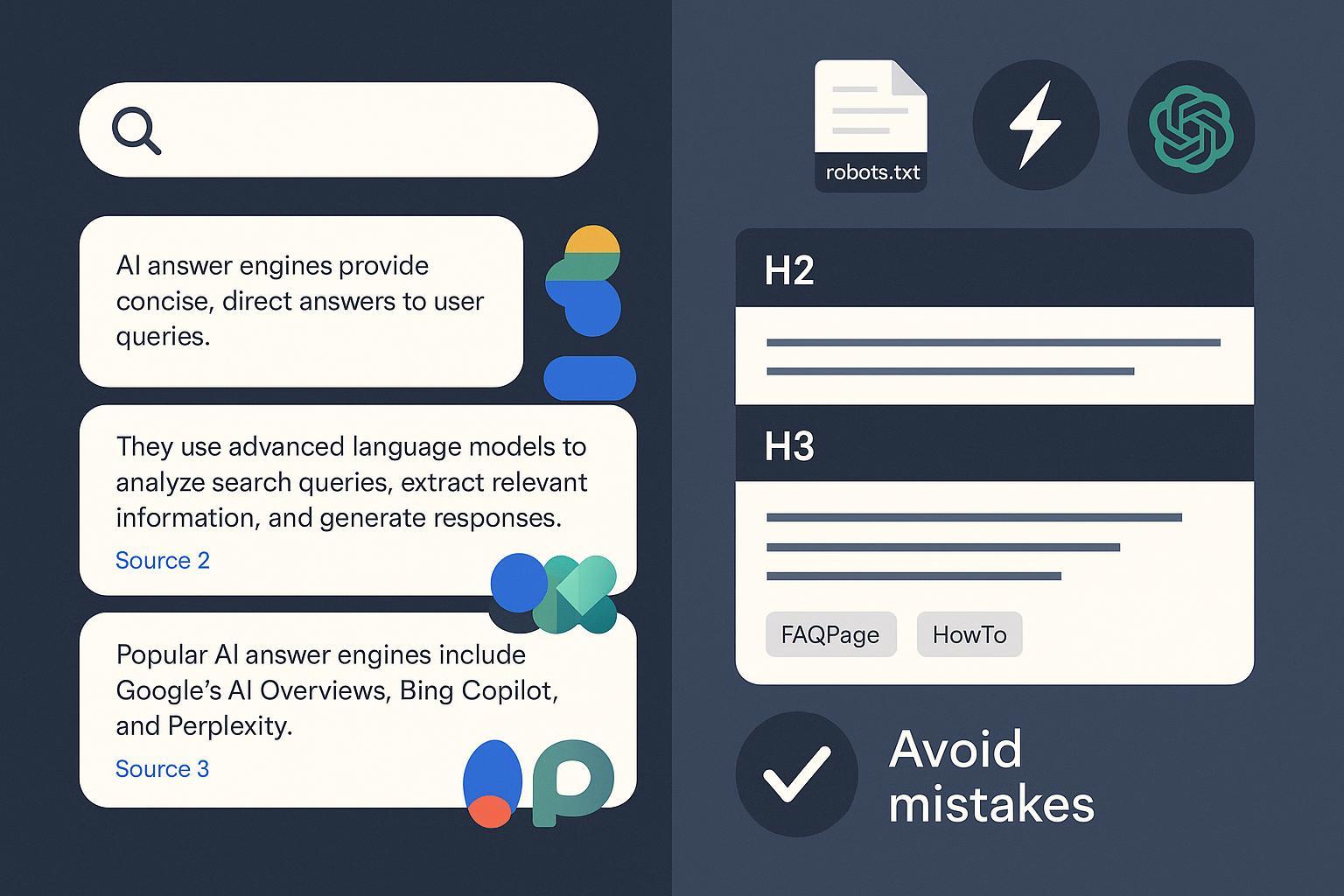Ultimate checklist for content that ranks in SEO and AI search engines
Actionable checklist to help your content rank in Google, Bing, and AI engines like Google AI Overviews, Bing Copilot, Perplexity, and ChatGPT. Covers E-E-A-T, schema, technical SEO, citations, and monitoring.

by
Tony Yan
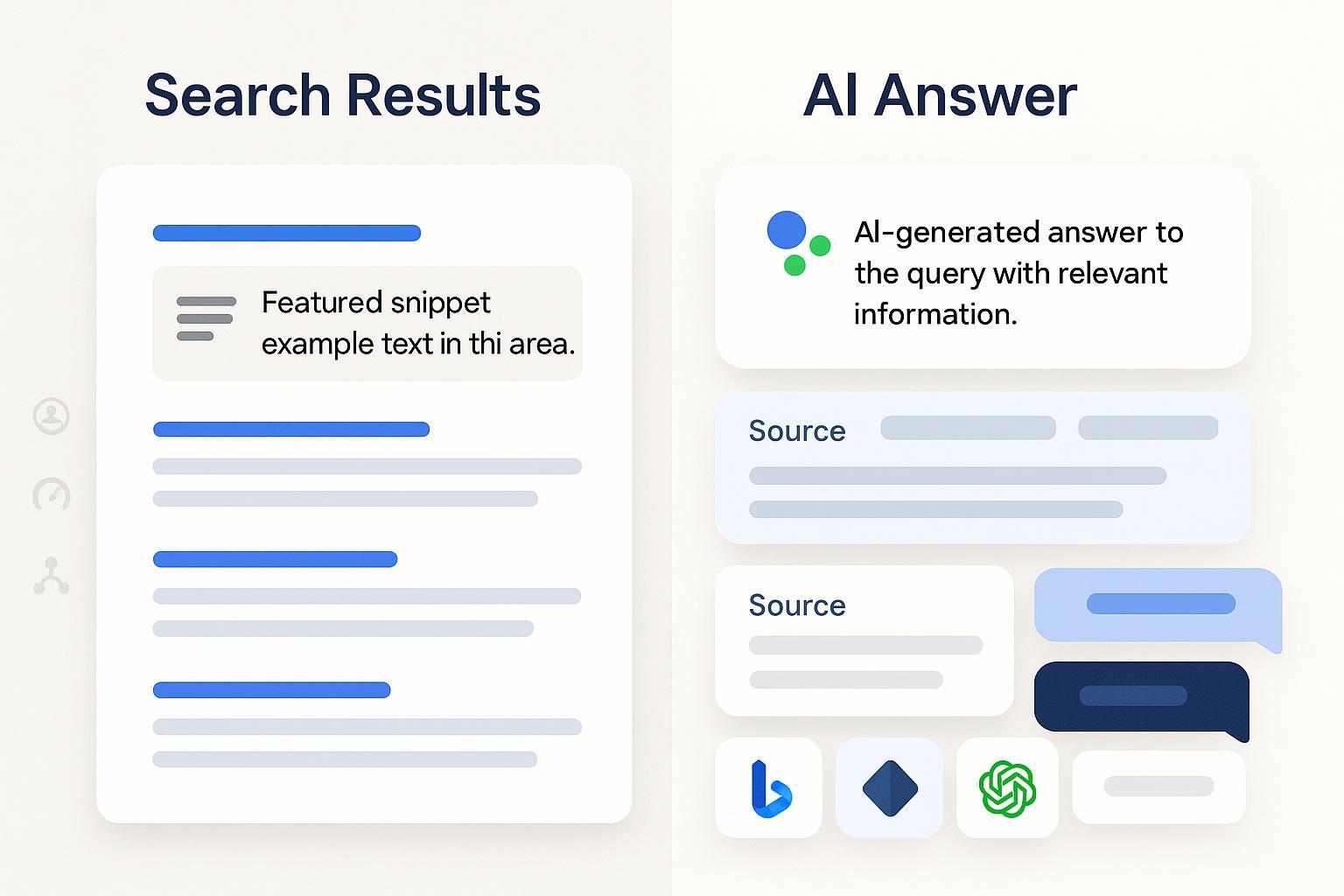
Use this practical, end-to-end checklist to ensure your content not only ranks in classic search results (Google/Bing) but also appears—and gets cited—in AI-driven answers (Google AI Overviews, Bing Copilot, Perplexity, ChatGPT Search). Each item starts with a clear action and includes why it matters.
Before you publish: research, strategy, and authority setup
- Define the primary intent and question set
- Identify the core question your page must answer and adjacent sub-questions users ask. Completion: You have a one-sentence purpose and a list of 5–10 sub-questions.
- Why this matters: AI answer engines and featured snippets favor pages that directly and comprehensively answer user intents.
- Map surfaces that may show AI answers
- Review query types that often trigger AI summaries (definition, comparisons, how-tos). Completion: You’ve flagged target queries likely to invoke AI Overviews/answer panels.
- Why this matters: Formatting and coverage depth can influence whether your page is cited in summary boxes.
- Collect authoritative primary sources to cite
- Save 3–6 primary, canonical sources you will reference in-content. Completion: Sources added to the draft with descriptive anchors.
- Why this matters: Referencing primary sources builds credibility for both traditional rankings and AI citations per Google’s people‑first guidance (see the 2025 overview in Creating helpful, reliable, people‑first content – Google Search Central).
- Establish authorship and reviewer plan (E‑E‑A‑T)
- Assign a qualified author; add expert reviewer for sensitive/YMYL topics. Completion: Bylines, bios, and review steps set.
- Why this matters: Google’s quality framework and search guidance emphasize clear authorship, experience, and review for trust, which supports rankings and citations.
- Align entities for your brand, author, and product/service
- Standardize Organization and Person names; list official profiles (sameAs). Completion: Entity sheet with exact names/URLs ready for schema.
- Why this matters: Consistent entities help search engines disambiguate and attribute expertise.
During creation: build answerable, structured, and credible content
- Lead with the answer, then expand
- Open with a concise answer paragraph; follow with sections that deepen coverage. Completion: First 1–2 paragraphs answer the main question directly.
- Why this matters: Summaries and engines extract top-level answers; clarity increases citation odds.
- Use question-led headings and scannable structure
- Organize H2/H3s as user questions; include lists, tables, and concise steps. Completion: Each sub-question maps to a heading.
- Why this matters: Engines and users benefit from explicit question/answer formatting.
- Add original value (examples, data, comparisons)
- Include unique data, original screenshots, or tested workflows. Completion: At least one proprietary insight or example per major section.
- Why this matters: Originality signals reliability and differentiates your content.
- Cite primary sources with descriptive anchors
- Link to canonical docs/studies inside the sentence, wrapping the fact phrase. Completion: Each non-obvious claim is supported with one authoritative link.
- Why this matters: It strengthens E‑E‑A‑T and aids AI engines that prioritize authoritative citations.
- Implement core structured data (JSON‑LD)
- Add Article markup with author and dates; use FAQPage and/or HowTo when appropriate. Completion: JSON‑LD validates with no critical errors.
- Why this matters: Structured data clarifies intent and improves eligibility for rich/AI surfaces. See Google’s structured data docs (2025) for Article, FAQPage, and HowTo.
Example snippet: Article + Author profile linking
{
"@context": "https://schema.org",
"@type": "Article",
"headline": "Your Definitive Guide to X",
"description": "Clear, concise summary of what this page covers.",
"image": [
"https://example.com/hero.jpg"
],
"datePublished": "2025-09-15",
"dateModified": "2025-10-01",
"author": {
"@type": "Person",
"name": "Jamie Rivera",
"url": "https://example.com/authors/jamie-rivera",
"sameAs": [
"https://www.linkedin.com/in/jamierivera/",
"https://x.com/jamierrivera"
]
},
"publisher": {
"@type": "Organization",
"name": "ExampleCo",
"url": "https://example.com",
"logo": {
"@type": "ImageObject",
"url": "https://example.com/logo.png"
}
}
}
Example snippet: FAQPage
{
"@context": "https://schema.org",
"@type": "FAQPage",
"mainEntity": [
{
"@type": "Question",
"name": "What is X?",
"acceptedAnswer": {
"@type": "Answer",
"text": "X is ... concise, user-facing explanation that matches on-page content."
}
},
{
"@type": "Question",
"name": "How do I implement X?",
"acceptedAnswer": {
"@type": "Answer",
"text": "Step 1..., Step 2..., include links to primary sources where relevant."
}
}
]
}
- Ensure on-page accessibility and clarity
- Provide descriptive alt text, proper heading hierarchy, sufficient color contrast, and keyboard-friendly UI. Completion: Page meets WCAG 2.1 AA checks.
- Why this matters: Accessibility supports users and can improve machine parsing; WCAG 2.1 is the reference standard (W3C, 2018+), see WCAG 2.1 Guidelines.
- Add a concise, helpful FAQ section
- Answer the top 3–6 related questions succinctly; avoid fluff. Completion: FAQ matches on-page content and is marked up.
- Why this matters: Q&A blocks are often extracted by AI engines; they also support long‑tail queries. For deeper tactics, see How to optimize content for AI citations.
- Use internal links to prerequisite and advanced topics
- Add 2–4 contextual internal links with descriptive anchors. Completion: Links point to high-quality, related resources.
- Why this matters: Supports topic depth and entity association; helps AI engines understand your site’s knowledge graph.
Technical and performance essentials
- Verify crawlability and indexability
- Confirm the page is not blocked by robots.txt or meta robots; set a canonical URL. Completion: URL Inspection shows “Indexed,” canonical is correct.
- Why this matters: Inclusion is table stakes; follow Google Search Essentials (2025) for technical requirements and anti‑spam policies.
- Apply snippet controls surgically (if needed)
- Avoid blanket nosnippet/data‑nosnippet; use max‑snippet for sensitive sections only. Completion: No over‑blocking of snippets.
- Why this matters: Overuse can suppress featured snippets and AI Overviews; see Google’s 2025 robots meta tag specifications.
- Optimize speed and UX (Core Web Vitals)
- Hit CWV targets (LCP, INP, CLS) and ensure mobile responsiveness. Completion: Passing Core Web Vitals in PageSpeed Insights and CrUX.
- Why this matters: Google highlights CWV as user‑centric performance metrics; see the 2025 Core Web Vitals overview.
- Prepare for mobile-first indexing and multilingual needs
- Ensure parity of content on mobile; use hreflang for locales. Completion: Mobile renders all key content and links correctly.
- Why this matters: Google’s indexing is mobile-first; mismatches can harm visibility.
Off‑page signals and credibility
- Pursue digital PR and authoritative citations; avoid scaled link schemes. Completion: 3–5 credible mentions for cornerstone pages.
- Why this matters: External references bolster authority for both rank and AI citations.
- Maintain consistent author and organization profiles
- Keep bios and org profiles updated across the web; align names, logos, and URLs. Completion: Updated LinkedIn, industry profiles, and knowledge panels (where applicable).
- Why this matters: Consistency reinforces entity trust.
Platform micro‑checklists: tailor for each AI surface
- Google AI Overviews / AI Mode
- Provide a clear, succinct top answer; structure with Q&A blocks and lists.
- Use FAQ/HowTo schema when it matches on‑page content; ensure recency (updated date).
- Avoid restrictive snippet directives on key explanatory sections.
- Why this matters: Google explains how sites can influence visibility and controls in 2025’s AI features and your website. For formatting tactics, see this practitioner guide to best practices for Google’s AI Mode optimization.
- Bing Copilot (AI answers)
- Structure content with straightforward headings, lists, and concise definitions; keep freshness strong.
- Use IndexNow for faster Bing discovery where appropriate.
- Why this matters: Microsoft’s 2025 announcement describes how Copilot Search surfaces answers with citations; see Introducing Copilot Search in Bing.
- Perplexity
- Allow official PerplexityBot if you choose to be included; check user agents and server logs.
- Emphasize clarity, authority, and updated content; Q&A and FAQs help citation selection.
- Why this matters: Perplexity documents its bots and crawling behavior; see PerplexityBot user‑agent guide.
- ChatGPT Search
- Publish clear, source‑rich explanations; avoid thin or boilerplate text.
- Monitor your robots policies regarding OpenAI crawlers and partners.
- Why this matters: OpenAI’s 2025 overview emphasizes timely results with linked sources; see Introducing ChatGPT Search.
Launch, monitor, and iterate
- Request indexing and verify appearance
- Submit the URL in Google Search Console; use Bing Webmaster Tools and IndexNow as applicable. Completion: Crawl requested; no critical errors.
- Why this matters: Speeds up discovery and debugging.
- Track rankings, traffic, and zero‑click visibility
- Monitor traditional KPIs and watch shifts when AI summaries appear. Completion: Dashboard tracks queries where AI answers show.
- Why this matters: Zero‑click realities require monitoring visibility, not just clicks. For combined SEO+GEO workflow, see this step‑by‑step guide to optimizing for SEO and GEO.
- Monitor AI citations and sentiment
- Record when/where your brand is cited in AI answers; note sentiment and gaps.
- Why this matters: Citations and tone influence trust and assisted conversions. Learn how to measure an AI Search Visibility Score.
- Refresh cadence and change logs
- Revisit pages quarterly or when intent shifts; update examples, data, and FAQs. Completion: DateModified updated; changelog entry added.
- Why this matters: Freshness and clarity affect both rankings and AI citation likelihood.
- Safe LLM prompt‑testing for summarization and citations
- Test your public pages with prompts like: “What is X? Cite sources.” across Google, Bing, Perplexity, and ChatGPT Search.
- Compare summaries and citations; adjust headings/FAQs for clarity and add missing primary sources.
- Document iterations; never paste confidential content into public tools.
- Why this matters: It reveals how engines interpret and cite your content so you can improve structure without guesswork.
Practical example: monitoring AI citations and sentiment
- Walk through a weekly workflow to verify citations and sentiment across engines.
- Run your target query set and record where AI answers appear.
- Open each answer panel and list cited domains; capture screenshots and dates.
- Note tone (positive/neutral/negative) and gaps in your coverage.
- Prioritize content updates where you’re missing or misrepresented.
- How teams operationalize this with Geneo: centralized tracking across Google AI Overviews, Perplexity, and ChatGPT; historical logs of brand mentions; and AI‑assisted sentiment tagging to spot risks and opportunities fast. This enables a repeatable cadence of monitoring, analysis, and refresh without hopping between tools.
Disclosure: Geneo is our product.
Governance and risk checks (run before publish)
- Validate against Google policies
- Ensure the draft avoids scaled, unoriginal content and complies with Search Essentials. Completion: QC checklist signed off referencing 2025 Google Search Essentials.
- Confirm schema accuracy and transparency
- Verify that every marked‑up element is visible to users and matches on‑page content. Completion: Rich Results Test passes; no misleading markup.
- Confirm snippet directive prudence
- Double‑check that nosnippet/data‑nosnippet are not suppressing key sections. Completion: Only sensitive content is restricted.
- Accessibility and device parity
- Re‑test WCAG basics, mobile rendering, and interactive elements. Completion: WCAG 2.1 AA spot‑checks pass; mobile parity confirmed.
- Primary sources are linked once with descriptive anchors; no link stuffing. Completion: External link density ~1 per 120–150 words.
Next steps
- If you’re setting up ongoing monitoring for AI answer visibility, brand mentions, and sentiment, consider trying Geneo to consolidate tracking and inform your refresh cadence with data. Keep your editorial and SEO teams aligned on the same weekly list of queries, citations, and fixes to steadily improve your footprint across both traditional search and AI answers.

by
Tony Yan

